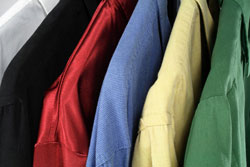Corona treatment for cotton material
Advances in polymer technology have given rise to the development of a huge range of textiles. The natural properties of cellulose based plant fibres can be mimicked by their artificial counterparts. However, in many cases there is no substitute for the natural material to produce the qualities that the consumer demands. A prime example is polycotton. By blending the two types of fibres, the easy care low shrinkage characteristics of polyester are obtained with the natural soft feel of cotton. Moreover, from an economic point of view, the cost of a synthetic/natural mix fabric is highly competitive. The use and or inclusion of cellulose-based fibres however can be problematic. They are all naturally repellent to water (hydrophobic) due to the large amount of impurities which form a barrier. Treatments during manufacture include dyeing, printing, bleaching, waterproofing and finishing to make them wrinkle-free. These processes necessitate that the material be uniform as far as absorption is concerned and this is difficult to accomplish due to variations in hydrophobicity. To eliminate the problem, several wetting agents can be applied. These increase the spreading and penetrating properties of a liquid by lowering its surface tension. Problems associated with the wetting agents are pollution, increased cost, foam formation and reduced production. Another way would be to increase the bath temperature but this can lead to aggregate formation within the bath. Project partners within EC funded CORTEX have researched into another means of solving this inherent problem. Scientists at Universidade do Minho in Portugal investigated the application of Corona plasmatic technology to modify the surface of the materials. This involved the application of an electrical discharge between an electrode and a counter-electrode, used only to make a connection to the electrolyte. Meanwhile, the fabric moves through the impregnation bath between the electrodes. The team also investigated the temperature and humidity levels required for the different materials in order to optimise the discharge effect. Textile material studied included cotton, flax, hemp and blends with synthetic fibres when there is a high proportion of the cellulosic material. A patent has been granted for the technology developed and its use with cellulose-based material. The overall result of application of this technology could be a more competitive textiles industry within Europe especially in the face of escalating competition globally.







